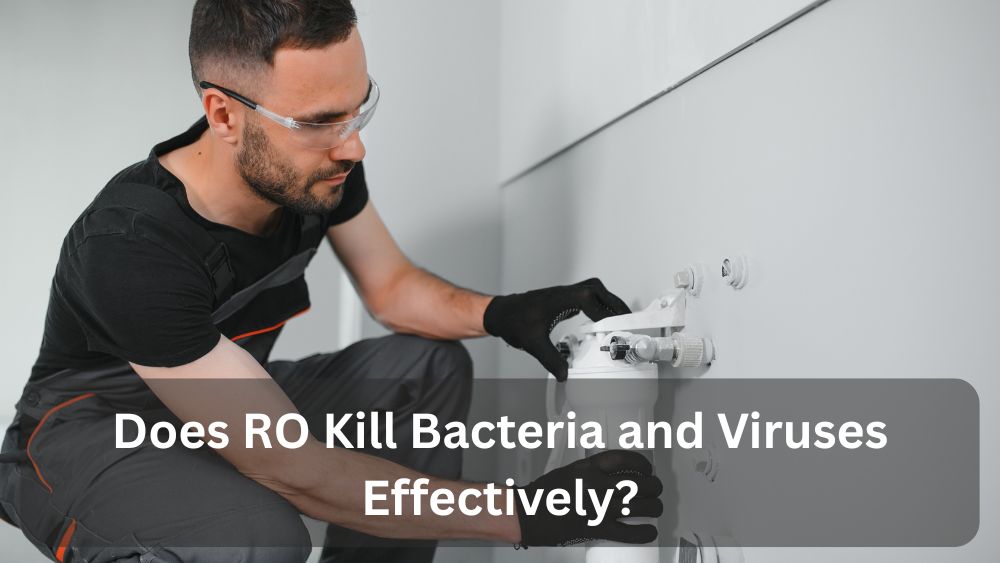When you think about safe drinking water, your first concern is often germs—bacteria, viruses, and other microorganisms that can cause serious illnesses. Waterborne diseases like cholera, typhoid, and hepatitis A remain major global threats, affecting millions every year.
Reverse osmosis (RO) systems are popular for removing salts, metals, and chemicals. But many people ask: Does RO kill bacteria and viruses too? The answer is slightly more nuanced. RO does not kill germs, but it can remove them effectively through ultra-fine filtration. Let’s dive deeper.
Key Takeaways
- RO membranes have pores of 0.0001 microns, small enough to block most bacteria and viruses.
- RO systems remove microbes but do not kill them.
- Combining RO with UV or UF filters ensures complete protection.
- Proper maintenance is essential—damaged membranes may allow bacteria through.
- RO systems are highly effective against microbial contaminants when paired with disinfection.
How Does Reverse Osmosis Work Against Microorganisms?
- The RO membrane acts like a microscopic sieve.
- Bacteria (0.2–2 microns) and viruses (0.02–0.3 microns) are larger than the membrane pores (0.0001 microns).
- As a result, they are physically blocked and flushed out with reject water.
Stat Insight: Studies show RO membranes can remove 99% of bacteria and 99–99.9% of viruses【Water Quality Association, 2022】.
Does RO Kill or Only Remove Bacteria and Viruses?
This is the key distinction:
- RO does not kill microbes.
- Instead, it removes them physically through size exclusion.
- Any bacteria trapped on the membrane surface are flushed out during the rejection process.
Which Microorganisms Can RO Remove?
| Microorganism | Size (microns) | Removed by RO? |
|---|---|---|
| E. coli (bacteria) | 0.2–0.5 | Yes (blocked) |
| Salmonella (bacteria) | 0.7–1.5 | Yes (blocked) |
| Vibrio cholerae (bacteria) | 1.5 | Yes (blocked) |
| Hepatitis A (virus) | 0.027 | Yes (blocked) |
| Rotavirus | 0.07 | Yes (blocked) |
| Norovirus | 0.02–0.04 | Mostly blocked, best with RO+UV/UF |
Why Do Some Experts Recommend RO + UV Together?
- RO removes but does not kill microbes.
- If a membrane gets damaged or fouled, bacteria can pass through.
- UV treatment inactivates microbes by destroying their DNA.
- Combining RO + UV gives double-layer protection.
How Effective Is RO Against Viruses Compared to Bacteria?
- Bacteria: RO removes almost all bacteria due to their relatively large size.
- Viruses: Smaller than bacteria, some may slip through if the membrane is compromised.
- Solution: Use RO with UV or UF for complete virus protection.
What Happens If You Don’t Maintain Your RO System?
- Biofilm may grow on filters or tubing.
- A damaged membrane can allow microbes through.
- Storage tanks may harbor bacteria if not sanitized annually.
Result: Even the best RO system won’t protect you if neglected.
Best Practices to Ensure Microbial Safety in RO Systems
- Change Filters on Time
- Pre-filters: every 6–12 months.
- Post-carbon: every 12 months.
- Replace RO Membrane Every 2–3 Years
- Keeps rejection rate high.
- Add UV or UF Disinfection
- Neutralizes viruses and bacteria that pass through.
- Sanitize Storage Tank Annually
- Prevents bacterial growth inside the tank.
- Flush System Regularly
- Avoids biofilm and fouling.
RO vs Other Disinfection Methods
| Method | How It Works | Effective Against | Limitations |
|---|---|---|---|
| Reverse Osmosis | Physical removal | Bacteria, viruses, chemicals | Needs maintenance |
| UV Purification | DNA inactivation | Bacteria, viruses | Doesn’t remove chemicals |
| Chlorination | Chemical disinfection | Bacteria, viruses | Leaves taste, byproducts |
| Boiling | Heat inactivation | Bacteria, viruses | Not practical daily |
Conclusion: RO combined with UV is the best balance of safety and convenience.
Frequently Asked Questions (FAQ)
1. Does RO alone make water safe from bacteria and viruses?
Yes, in most cases, RO membranes block 99%+ microbes. But adding UV ensures total safety.
2. Can viruses pass through RO membranes?
Most viruses are blocked, but very small ones like norovirus may slip through if the membrane is damaged. That’s why UV is recommended.
3. Do I still need to boil water if I have RO?
No, not if your RO is well maintained and paired with UV. Boiling is an extra precaution in emergencies.
4. How often should I sanitize my RO system?
At least once a year. If your water source is heavily contaminated, sanitize every 6 months.
5. Is bottled RO water safe from microbes?
Yes, but safety depends on how the water is stored. Contamination can occur after purification if handling is poor.
Conclusion
So, does RO kill bacteria and viruses effectively? Not exactly—it doesn’t kill them, but it removes them with very high efficiency. For households, this means an RO purifier provides excellent microbial protection. And when paired with UV or UF technology, it delivers complete peace of mind.
Here’s the bottom line:
- RO membranes physically block bacteria and most viruses.
- Adding UV ensures even the tiniest microbes are neutralized.
- Regular maintenance is essential to keep your RO effective.
With the right setup, your RO system can protect your family against harmful bacteria and viruses, ensuring every drop of water you drink is safe.

Hasan Al Sarker is a Reverse Osmosis Specialist. He has worked for many years to ensure safe drinking water for all. His research paper has been published in several journals, including Issue, Medium, and Slideshare. He is recognized as a water doctor among specialists though he did not attend medical college.
Besides working as a researcher of reverse osmosis technology, he is also very fancy with the kitchen and cooking. His guides are reading thousands of people every day. As a head of content, he is responsible for all the published articles at RO System Reviews.

